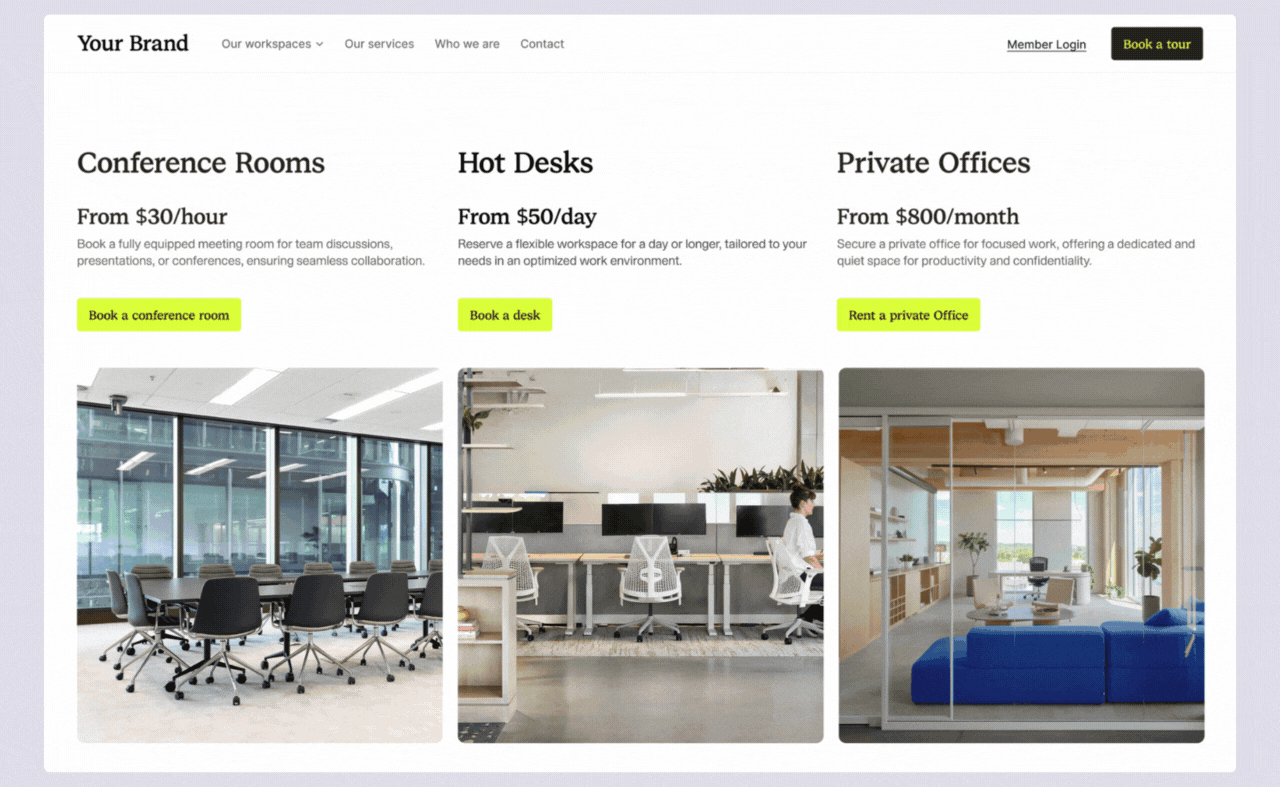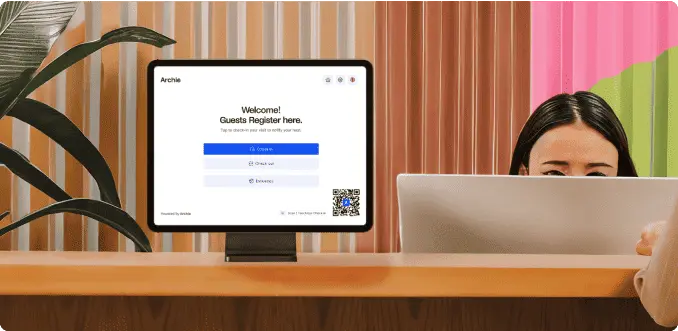If you’re about to open a coworking space (or you’ve just done so recently), figuring out coworking space profitability is probably high on your to-do list. Given that 46% of coworking spaces turn profitable after one year, you might be wondering: Are coworking spaces profitable? And if so, what exactly makes coworking spaces successful?
To help answer these big questions (and a few more), we’ve teamed up with Abigail Schilling to break it all down for you.
Abigail owns and runs three successful coworking spaces in Oregon, so she knows firsthand what it takes to make coworking spaces profitable. Through her agency, Space Savvy Studio, she helps coworking spaces improve everything from daily operations to marketing and tech solutions to create better experiences for members.
Guide to coworking space profitability
Are coworking spaces profitable?
Many coworking spaces are profitable, but profitability doesn’t happen overnight. On average, most coworking spaces take about two years to start turning a profit.
And it’s not always smooth sailing — research shows that many coworking spaces still face financial pressure. Nearly half of spaces struggle to make consistent profit, and about one-quarter operate at a loss. In Germany, for example. only about 20% of coworking spaces are truly profitable, and more than 40% are just breaking even.
The good news is that the coworking industry is bouncing back, with the global market valued at $13 billion and expected to grow by around 15% each year. But for that growth to continue, coworking operators need to focus on running their spaces in a way that makes them more financially sustainable.
Luckily, smarter coworking operations and technology are helping. Automation tools (like billing, booking, access control, and visitor systems) can free up more than 15 hours a week, letting teams focus on members instead of admin. And dynamic pricing powered by AI is becoming a real game-changer, too. Although it’s controversial, operators using it have reported revenue increases of around 50%, without needing to raise base prices across the board.
So, what’s the takeaway?
Coworking is growing and maturing. Coworking profitability depends on scale, smart space planning, and digital tools. The spaces that run lean, design for everyday usage, and use automation to save time tend to do better. And as the industry continues to professionalize, the profit outlook is getting stronger, especially for operators who take a strategic approach rather than relying on foot traffic alone.
What is the profit margin on coworking spaces?
Coworking space profit margins can vary quite a bit depending on how big the space is, where it’s located, and how well it’s run.
Small spaces often just break even or even lose money, especially in the beginning. Medium-sized spaces with around 50 to 150 members usually see a profit margin of about 10% to 20%. Bigger spaces with more than 150 members tend to do even better, with margins around 20% to 30% or higher. It also depends on how well operators handle common challenges that affect coworking space profitability, which we’ll dive into next.
Key coworking profitability challenges
Based on the latest coworking statistics and market trends, some of the biggest challenges affecting coworking profitability are:
Size & location
To start with, coworking space size plays a huge role:
- Small spaces (up to 50 members): Often struggle to turn a profit and may only break even.
- Medium spaces (50-150 members): Typically see profit margins of around 10-20%.
- Large spaces (150+ members): Can achieve 20-30% profit margins or more.
Then, location matters too. Downtown coworking spaces can charge higher membership fees, but they also have higher rent and operating costs. Meanwhile, suburban or small-town spaces may charge less but benefit from lower expenses, making coworking space profitability more achievable.
High operating costs
Running a coworking space can be expensive, especially in big cities where rent is high. Some of the biggest costs include:
- Rent and utilities – Leasing a workspace in a prime location can be costly. On top of that, electricity, water, heating, and internet bills add up quickly.
- Furniture and equipment – A good coworking space needs comfortable desks, chairs, high-speed WiFi, printers, and meeting rooms with proper tech setup. These can be expensive to buy and maintain.
- Staff salaries – Many coworking spaces hire community managers, cleaning staff, and IT support to keep things running smoothly. Paying salaries every month is a major expense.
- Maintenance and upgrades – Keeping the space clean, fixing broken equipment, and updating the design to stay modern also cost money over time.
If a coworking space doesn’t generate enough income, these costs can quickly outweigh its earnings, making it hard to turn a profit.
Competitive pricing & member retention
Coworking spaces need to balance affordable prices with covering their expenses. Many owners keep membership fees low to attract members, but this can make it difficult to earn enough money to stay profitable.
- Freelancers and startups prefer budget-friendly options – Many people who use coworking spaces are looking for an affordable alternative to traditional offices. If prices are too high, they may choose another space or work from home instead.
- Members come and go – Unlike traditional office leases, coworking memberships are often month-to-month, meaning people can cancel anytime. When businesses struggle financially or remote workers return to company offices, coworking spaces can quickly lose members.
To stay profitable, coworking spaces need to find a pricing model that attracts customers while still covering their costs. Some do this by offering tiered memberships, where members can pay more for extra benefits like private offices, meeting rooms, or event spaces. Others introduce long-term contracts with discounts to encourage commitment.
Tough competition
In big cities, members have dozens of options, from large corporate chains like WeWork and Regus to smaller, community-focused spaces.
- Big brands dominate – Large coworking chains can afford prime locations, modern designs, and competitive pricing, making it difficult for smaller, independent spaces to attract members.
- New spaces pop up constantly – With more coworking spaces opening, existing ones need to keep evolving to stay relevant. Offering unique perks, building a strong community, or catering to specific industries (like tech or creative professionals) can help attract loyal members.
Smaller coworking spaces often need to focus on niche markets to survive. Some target specific industries, like coworking spaces designed for healthcare startups or creative professionals. Others emphasize a strong community feel with networking events, business mentorship, or wellness programs.
Economic uncertainty & real estate challenges
Coworking spaces are closely tied to the economy and real estate market. When times are tough, fewer people and businesses can afford coworking memberships.
- Financial downturns – During economic slowdowns, startups and freelancers may cut expenses and cancel their memberships. This leads to lower income for coworking spaces.
- Real estate costs – If office rental prices increase, coworking spaces may struggle to keep up with high lease payments while keeping membership prices affordable.
Some coworking spaces respond by offering flexible memberships, such as daily or hourly passes, which appeal to professionals who only need a workspace occasionally. Others diversify their income by renting out meeting rooms, hosting events, or providing business support services.
How do coworking spaces make profits?
The most profitable coworking spaces typically have high occupancy rates, smart layouts, and flexible membership options in common:
Membership structure
Membership fees are the most significant contributor to a coworking space’s financial success, accounting for about half of overall profitability. Various membership options — like day passes, hot desks, dedicated desks, and private offices — help attract diverse members. This flexibility not only meets different needs but also maximizes revenue potential.
Coworking profitability tends to kick in once the membership count reaches approximately 100, with coworking space profit margins improving as the number of members increases.
Location and overheads
Location is a game-changer for coworking spaces, influencing their appeal to members and operational expenses.
- Attracting members: A prime city-center location can draw more members by offering convenience, accessibility, and prestige. Proximity to amenities like cafes, restaurants, and public transport also adds value. Coworking spaces in peripheral urban areas or smaller cities often achieve profitability thanks to lower rent costs.
- Operational expenses: While popular locations offer benefits, they have high rental costs that can eat into profits. Other operational expenses — staffing, utilities, maintenance, and insurance — vary by location.
To optimize profitability, coworking spaces can focus on lease negotiations, creative space utilization, and introducing new revenue streams to offset higher costs. Balancing your revenue and expenses to hit a healthy profitability range is key, no matter where your space is located.
Additional revenue streams
Successful coworking spaces don’t rely solely on membership fees. Diversifying income sources can significantly boost profits. This might include:
- Hosting events or workshops.
- Offering consulting or business services.
- Running on-site amenities like cafes or retail spaces.
Coworking spaces can create a more sustainable and profitable business model by tapping into these extra opportunities.
When I first opened my coworking space, I focused on long-term members and office sales. After a few months, I realized that this traditional focus was limiting the number of people I could convert, and I was missing out on a large market segment that was active in my region. Not wanting to miss out on potential revenue, I decided to diversify my service offerings and target a broader audience. I saw the untapped potential of non-members and the rising demand for flexible options for room bookings and day pass users. I developed a public online signup and booking page, making it effortless for anyone to discover and access the coworking space. I also integrated self-serve automations for both bookings and day passes to cut down on the work that would be required to onboard and serve these bookings. The ease of online bookings attracted new users, significantly driving up utilization rates and diversifying revenue streams.
Through her agency, Space Savvy Studio, Abigail helps coworking operators boost profitability. Take Joanna, for example: her coworking space faced high expenses, staff turnover, and ineffective marketing, putting her business in serious trouble. Despite her best efforts, the space’s financial health was deteriorating, and things were just getting worse as she struggled to look at the right data and relied on ineffective marketing strategies.
Realizing she needed a fresh approach, she turned to the coworking expert to review her business. Together, they identified key areas where expenses could be cut without compromising service quality. They recognized the need for “the right person in the right seat” and agreed that there was no “unicorn” — no single person could handle all the tasks. This led to outsourcing certain operations, such as marketing and financial management.
This strategic realignment and outsourcing led to a strong turnaround. Operational costs were reduced, and the effectiveness of marketing efforts improved, attracting more members, room bookings, and revenue. Joanna’s space now operates more efficiently, with a leaner, more focused team and external partners, like Space Savvy Studio, that drive success.
Understanding costs in coworking spaces
Running a profitable coworking space comes with a mix of fixed and ongoing costs. Some contribute directly to revenue, while others are essential for keeping the space functional and attractive for members:
Fixed costs (one-time investments)
- Coworking space furniture and infrastructure: This includes the basics like desks, chairs, lounge seating, and other furnishings needed to set up the coworking space.
- Tech installations: Setting up reliable Wi-Fi, security cameras, and other technology systems.
- Initial marketing and branding: Expenses for launching the space, such as opening events, creating a professional logo & other branding materials, and digital marketing campaigns to attract early members.
- Construction and renovations: These include remodeling costs, such as painting, flooring, electrical work, plumbing, and adding partitions or private booths. They might also include meeting local building codes, accessibility upgrades, and customizations to create a functional and appealing environment.
Ongoing costs
- Lease/rent: Often the largest recurring expense, especially for spaces in high-demand locations.
- Utilities: Covering essentials like electricity, water, and heating/cooling.
- Staff salaries: Paying community managers, cleaners, and other team members who keep the space running smoothly.
- Maintenance and cleaning: Regular upkeep ensures the space stays in great shape.
- Software and Internet: Costs for coworking software, high-speed internet, and other tech services.
- Sales and marketing: Ongoing efforts like advertising, hiring contractors for special projects, and hosting events to attract and retain members.
- Supplies and community perks: From toilet paper to coffee and snacks, these small touches create a positive experience and a sense of community.
How to make a coworking space profitable
Utilization is a crucial metric in knowing your profitability. If you look around your space at any given moment and see a certain percentage of space is not being used, your #1 priority is getting it to generate revenue.
#1 Optimize your coworking space with strategic floor planning
Every part of your coworking space should serve a purpose to maximize profitability:
Make every (work)space count
A thoughtful coworking space floor plan can balance revenue generation with member satisfaction. Take community areas like lounges and kitchens, for example. They’re great for casual chats, quick breaks, and helping people connect — but they shouldn’t take up your most valuable spots. You can make these spaces more efficient by combining them with other areas, like placing a coffee bar near a hallway or using a lounge that can also host small events.
Private offices are usually your biggest source of income. They bring in steady revenue, but they shouldn’t take over the entire floor. A good mix of private offices, open desks, and cozy nooks gives members options, which can help you attract a wider range of people.
You can also get creative with the space you already have. Maybe a large open area becomes a venue for workshops after hours, or that quiet corner turns into a focus pod or a phone booth. These little changes can make a big difference in how useful (and profitable!) your coworking space becomes. Speaking of…
Adapt and repurpose underutilized areas
Strategic floor planning isn’t just about initial coworking space design; it’s an ongoing process. As your community grows and member needs change, your layout should adapt too.
Pay attention to how different areas are used throughout the day. If a certain room sits empty most mornings, maybe it could be turned into a quiet work zone, a pop-up meeting space, or even a spot for workshops or coaching sessions.
It’s also worth looking at how people move through the space. A well-designed layout encourages natural flow and creates more chances for members to interact—whether it’s bumping into each other in the kitchen or chatting in shared lounges. The goal is to use every square meter in a way that supports both community and your bottom line.
Use coworking tools to optimize your space
To run a successful and profitable coworking space, it’s important to track how your space is being used and how your business is growing. The good news? The best coworking management tools like Archie can give you all this info in one place, without the spreadsheets.
You can start by checking your utilization rate — this tells you how well your space and resources are being used. Next, look at occupancy trends to see which desks or rooms are most popular and which ones might need a rethink.
It also helps to track member retention and repeat bookings, which are strong signs that people are happy and likely to stick around. On the financial side, monitor your operating costs per square foot to make sure your space is running efficiently.
And for a bigger picture view, compare your customer acquisition costs with lifetime value. This helps you plan smarter, spend better, and grow sustainably.

Ask members for feedback
The people who use your coworking space every day are your best source of insight. Ask them for feedback regularly to find out what’s working, what’s not, and what they would love to see next.
An easy way to do this is by placing QR codes around the space that link to a quick feedback form. You can also chat with members directly or send out short surveys now and then to dig a little deeper.
Taking the time to listen shows your members you care, and it helps you make smart decisions about how to improve the space. When you mix member feedback with smart floor planning and the right coworking tools, you’ll be able to create a space that runs smoothly, keeps members happy, and stays profitable over the long term.
But that’s not everything you can do.
#2 Rethink your pricing and fee strategies
Getting your pricing right is key to running a profitable coworking space. Consider the following:
- Competitive pricing: Take a good look at your pricing compared to others in your area. Are you offering more or less? Don’t be afraid to adjust your prices to reflect the true value of your space, especially as your services and costs change.
- Pass on transaction fees: You might also want to think about passing along credit card processing fees to members — just be sure to check local laws and clearly explain it so there are no surprises.
- One-time fees: A small setup or joining fee can cover onboarding time, while a non-refundable deposit helps reduce last-minute cancellations or no-shows.
- Automatic renewals: This helps you keep your cash flow steady each month and saves your team time by cutting down on admin tasks. Just make sure your members know about it upfront.
- Annual price increases: Consider small, annual price increases to keep up with inflation and rising expenses. If you’re open and honest about why prices are going up, most members will understand—and you’ll protect your business for the long run.
#3 Offer flexible membership options
Having different membership plans is one of the best ways to make your coworking space more appealing and accessible. Not everyone works the same way — some people need a desk every day, while others just want to drop in a few times a month or attend community events.
Giving people options lets members grow with you, instead of outgrowing you! Here are some examples to consider:
- Lounge membership: Access to casual spaces for networking or light work.
- Access membership: General access with discounts on desks or meeting room bookings.
- Part-time membership: Includes a limited number of day passes per month.
- Social membership: Grants access to networking events and resources without workspace use.
- Flex desk membership: Open seating is available for members who want flexibility.
- Dedicated desk membership: Reserved desks for those who prefer consistency.

#4 Focus on attracting and retaining members
Finding new people to join your space and making sure your current members feel valued and want to stick around is key for the long-term success of your coworking space.
There are a few things you can offer, like special deals for newcomers, for example. Free trials, first-month discounts, or limited-time offers can be a great way to bring in freelancers, startups, and remote workers who are curious but not quite ready to commit. Once they’re in the door, show them the value of staying.
Then, consider loyalty programs. You could give bonuses when they refer a friend, offer discounted rates the longer they stay, or unlock extra perks like free meeting room hours or premium coffee.
Another way to add value is by building connections in your local community. Team up with nearby cafes, gyms, or stores to offer mutual discounts. It’s a win-win — you support local businesses, and your members feel like they’re getting more than just a desk.
You can also offer add digital perks. Partner with software providers to give members special access or discounts on tools that help them work better, like project management apps, design tools, or accounting software. It’s these little extras that can help your space stand out and make members feel like they’re part of something special.
#5 Manage coworking expenses, not just revenue growth
Profitability in a coworking space isn’t just about bringing in more members — it’s also about controlling costs. Managing expenses wisely is as necessary as growing revenue to ensure long-term success. Here’s how:
- Improve energy efficiency: To lower utility bills, adopt energy-saving measures like LED lighting, smart thermostats, and motion-sensor lighting.
- Buy in bulk: Purchase essential items like coffee, snacks, and office supplies in bulk to save on costs and ensure a steady supply for members.
- Leverage technology: Use integrated coworking tech stack to streamline operations like guest check-ins, member billing, and event registrations. Automation reduces the need for manual processes and lowers labor costs.
- Partner with vendors: Collaborate with suppliers for better deals on amenities or shared resources, such as coffee machines or maintenance services, to reduce costs while maintaining quality.
- Introduce self-service options: Make it easy for members to handle simple tasks themselves with the coworking software. For example, touchless visitor management or self-service meeting room booking can reduce staff involvement, freeing your team to focus on higher-value tasks.
- Outsource where it makes sense: For tasks that don’t require in-person attention — like accounting, IT support, or coworking space marketing — consider outsourcing to remote professionals or contractors. This approach can be more cost-effective than maintaining a full-time staff for specialized roles.
- Standardize processes: Develop clear, repeatable workflows that anyone on your team can follow. These systems ensure smooth coworking operations, reduce training time and keep things running efficiently even during staff transitions.
- Hire and retain skilled staff: Invest in hiring talented, adaptable community managers and team members who can handle multiple responsibilities. A well-trained, efficient team can deliver excellent service while minimizing overhead.
- Focus on high-demand events: Eliminate low-participation events and use data insights to plan activities that attract more members. This ensures your resources are spent on initiatives that provide real value.
The key is finding the right balance — keeping your coworking space affordable to run while still delivering a top-notch member experience. That’s how you build a business that lasts.
How can you generate even more revenue for your coworking space?
Membership fees are the main source of income for most coworking spaces, but adding a few extra ways to earn money can really help your business grow and make your space even better for your members.
Here are some ideas:
- Hosting events and workshops. Transform your space into a venue for paid events, industry meetups, or seminars. These activities generate extra income and strengthen your community and visibility.
- Partnering with local sponsors. Collaborate with local businesses to sponsor events. For instance, they could provide food or drinks in exchange for exposure or pay a sponsorship fee to promote their brand in your space.
- Offering food and beverages: Set up an in-house café that serves coffee, snacks, and quick meals for busy professionals. You can also combine staffing with your coworking team for efficiency. Plus, you can install self-serve vending machines to provide refreshments with minimal management effort.
- Handling mail: Offer mail-handling services or virtual office packages for members and non-members. This attracts freelancers or businesses that don’t need a physical workspace but still want a professional address.
- Providing administrative support: Help members streamline their work with services like scheduling, answering calls, or email management. These can be offered as premium add-ons to their memberships.
- Renting office amenities: Charge for access to office essentials like printing, scanning, or supplies. These pay-per-use services meet practical needs while adding to your revenue.
- Renting high-tech tools and spaces: Offer specialized equipment like podcasting gear, VR headsets, or design tools on a rental basis. Rent out unique spaces such as podcast studios, brainstorming rooms, or video conferencing suites for members and non-members.
- Selling merchandise: Create branded merchandise, such as mugs, notebooks, or T-shirts, to sell to members and visitors. This generates income and acts as free advertising when your brand is seen outside the space.
- Hosting pop-up shops: Partner with local artists, makers, or small businesses to host pop-up shops. This supports the local economy and creates a fresh, engaging environment for your members.
- Building a healthy sales culture: Sales in coworking can sometimes feel like a dirty word, but it shouldn’t. As David Walker, Owner of CoworkingConsulting.com & Founder of Coworking Ecosystem Network, puts it:
A healthy sales culture is not about pressure or quotas, it is about hospitality. Every interaction is an opportunity to help a member or visitor find more value in the space. That could mean recommending a private office, highlighting the benefits of a meeting room package, or introducing a local company to a corporate membership option. When staff see sales as part of serving, growth feels human and natural. Revenue rises because members feel cared for and connected, not because they were pushed. In this way, sales culture and community culture reinforce one another.
Improve your coworking profitability with Archie
Archie helps coworking spaces like yours become more profitable by making day-to-day operations much easier and more efficient. Instead of juggling multiple tools or spending hours on admin tasks, everything you need is all in one place. That means your team can spend less time on the boring stuff and more time focusing on growth and keeping your members happy.
For starters, Archie makes it super easy for people to book desks, meeting rooms, or even parking spots with just a few clicks. Members can manage everything on their own — from booking to payment to accessing the space, without needing help from your team. Billing is also nice and easy. Invoices are sent automatically, payments are collected on time, and everything can be synced with your accounting tools.
On top of that, visitors get a great first impression with Archie’s check-in system, which can help turn casual guests into new members. Behind the scenes, Archie gives you smart reports so you can see which spaces are being used the most, when your peak hours are, and where there’s room to grow.
You can even boost revenue by selling extras like day passes, snacks, or event tickets right through the app. Plus, with built-in sales tools, you can keep track of leads and easily follow up to convert them into paying customers.
Here’s a quick look at how Archie helps boost profits:
- Easy bookings: Members can reserve desks, rooms, or other resources in seconds.
- Self-serve system: Members can handle payments, bookings, and access on their own.
- Automated billing: Invoices and payments are managed automatically, with accounting integrations.
- Visitor check-in: Give guests a great first experience and convert them into members.
- Smart reports: Track space usage, spot trends, and find ways to improve revenue.
- Sell extras: Offer passes, snacks, or event tickets right through Archie.
- Member experience: A smooth, easy experience keeps people coming back.
- Sales & CRM features: Manage leads and follow-ups to turn interest into income.

Sample coworking profit and loss report


Sources
- Insights from Abigail Schilling, Principal at Space Savvy Studio
- Global Coworking Survey
- The Latest Coworking Statistics & Industry Trends [2025]

Berenika Teter
Archie's Content Manager, fueled by filter coffee and a love for remote work. When she’s not writing about coworking spaces and hybrid workplaces, you can probably find her exploring one.



















![The Latest Coworking Statistics & Industry Trends [2026] A cozy coworking space with wooden walls, warm lighting, and a large map of South America.](https://archieapp.co/blog/wp-content/uploads/2025/08/Latest-coworking-statistics-cover-image-400x400.jpg)
![How To Start a Coworking Space: Costs and Plan [2026 Guide] A modern coworking space with white desks, ergonomic chairs, and laptops.](https://archieapp.co/blog/wp-content/uploads/2023/11/Screen-Shot-2023-11-30-at-9.33.09-AM-400x400.png)
